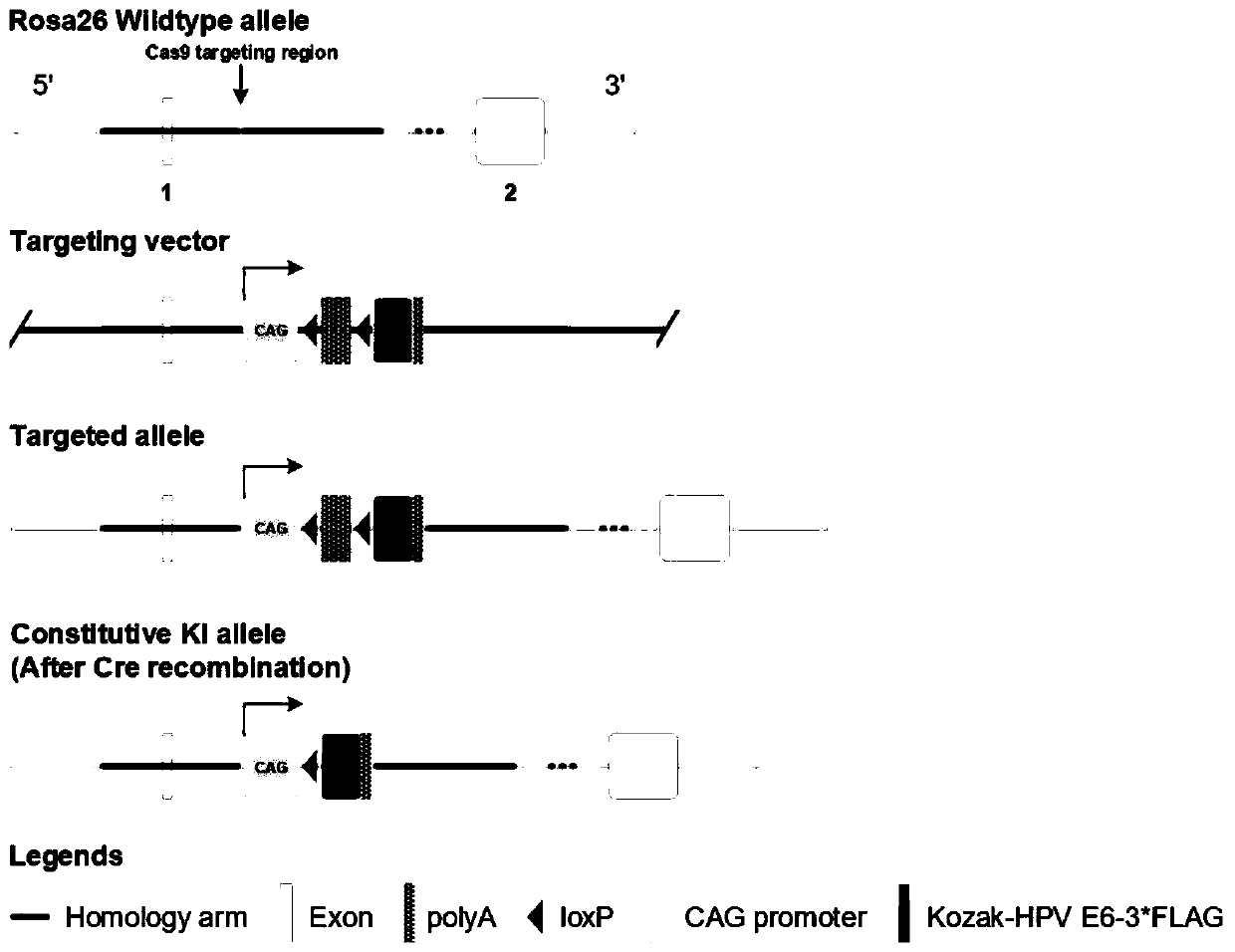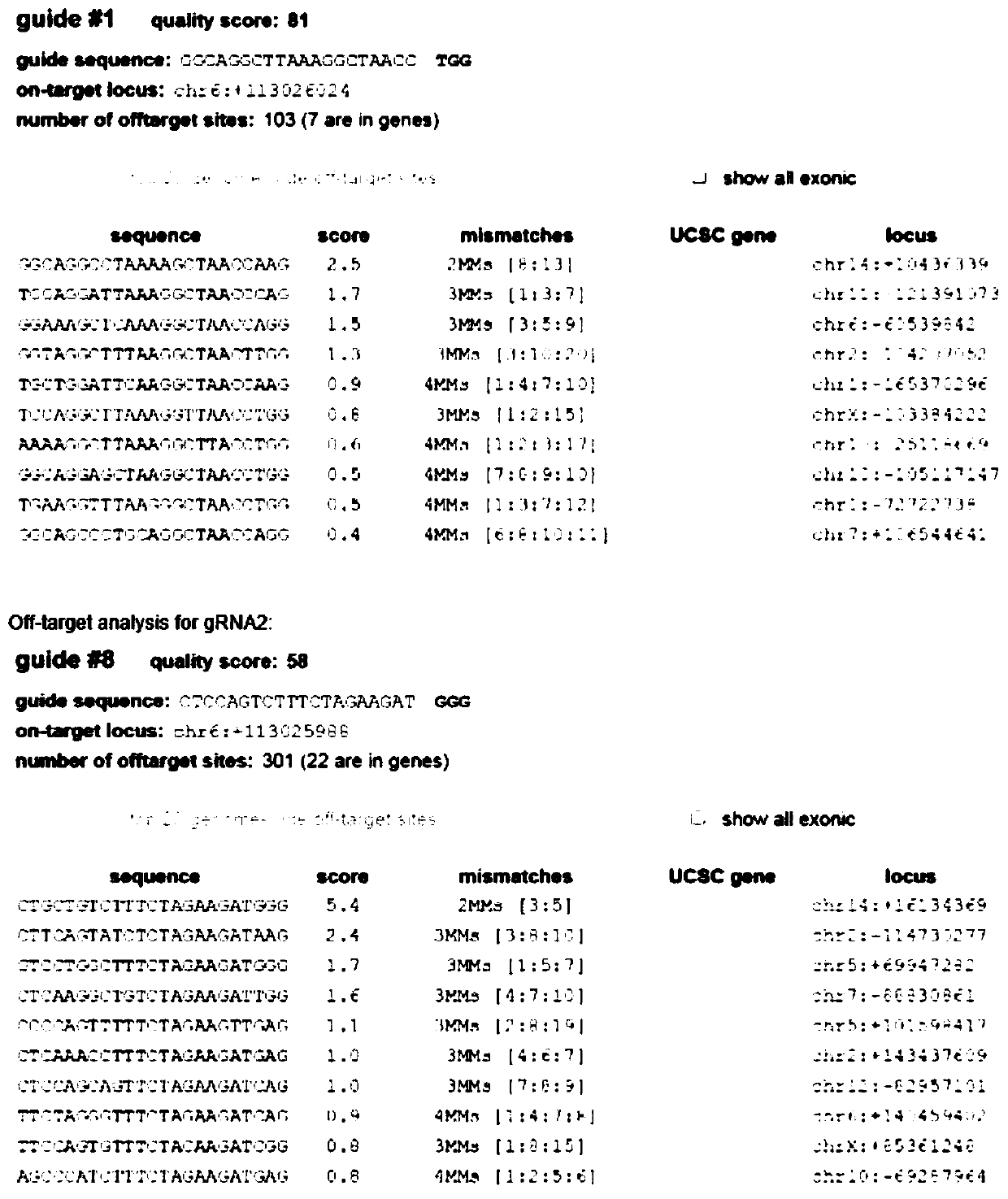Construction method for mouse model realizing conditional site-specific double-overexpression of HPV E6/E7 genes
A technology of mouse model and construction method, applied in the biological field, can solve the problems of genome rearrangement, non-expression, unfavorable control of gene expression level and function research, etc.
- Summary
- Abstract
- Description
- Claims
- Application Information
AI Technical Summary
Problems solved by technology
Method used
Image
Examples
specific Embodiment 1
[0093] Specific example 1: Carry out the construction of conditional overexpression HPV16 E6 animal model at ROSA26 site
[0094] Using CRISPR-Cas9 gene editing technology to knock in the HPV16 E6 gene sequence at the ROSA26 site of the mouse model, the conditional overexpression of HPV16 E6 can be achieved, so as to establish the conditional overexpression of HPV16 E6 mouse model. Including the following steps:
[0095] (1) sgRNA design and evaluation of off-target effects
[0096] sgRNA design for conditional overexpression of HPV16 E6 at the ROSA26 locus in C57BL / 6 mice, and evaluation of off-target effects of candidate sgRNAs, such as figure 2 shown. Screening to get sgRNA(matching forward strandofgene):
[0097] CUCCAGUCUUUCUAGAAGAUGGG.
[0098] (2) co-incubating the obtained sgRNA with the Cas9 protein to prepare a Cas9 / sgRNA mixture;
[0099] (3) Gene editing strategy and targeting vector construction
[0100] The overall strategy of gene editing is as follows: f...
specific Embodiment 2
[0136] Specific embodiment 2: Carry out the construction of conditional overexpression HPV16 E7 animal model at H11 site
[0137] Using CRISPR-Cas9 gene editing technology to knock in the HPV16 E7 gene sequence at the H11 site of the mouse model, the conditional overexpression of HPV16 E7 can be achieved, so as to establish the conditional overexpression of HPV16 E7 mouse model. Including the following steps:
[0138] (1) sgRNA design and evaluation of off-target effects
[0139] sgRNA design for conditional overexpression of HPV16 E7 at the H11 site of C57BL / 6 mice, and evaluation of off-target effects of candidate sgRNAs, such as Figure 14 . Screening to get sgRNA(matching forward strand ofgene):
[0140] GAACACUAGUGCACUUAUCCUGG.
[0141] (2) co-incubating the obtained sgRNA with the Cas9 protein to prepare a Cas9 / sgRNA mixture;
[0142] (3) Gene editing strategy and targeting vector construction
[0143] The overall strategy of gene editing is as follows: Figure 13...
specific Embodiment 3
[0177] Specific Example 3: Generation of conditional site-directed HPV16 E6 / E7 double knock-in mice
[0178] Method for obtaining conditional site-directed HPV16 E6 / E7 double knock-in mice by hybridization: the ROSA26 site conditionally overexpressing HPV16 E6 homozygous mice constructed in Example 1 and the H11 site conditionally overexpressing HPV16 E7 in Example 2 The homozygous mouse model was crossed to obtain the positive offspring of conditional site-directed HPV16 E6 / E7 double knock-in mice. The offspring after heterozygosity are 100% homozygous, and genotyping may not be performed.
[0179] The present invention provides a conditional site-specific HPV E6 / E7 double transgenic mouse model established by transgenic technology, so as to obtain an animal model that can be genetically stable and conforms to the true pathological state of HPV infection. This model will be used to study the in vivo function analysis of the key HPV oncogene E6 / E7, the exploration of disease ...
PUM
 Login to View More
Login to View More Abstract
Description
Claims
Application Information
 Login to View More
Login to View More - R&D
- Intellectual Property
- Life Sciences
- Materials
- Tech Scout
- Unparalleled Data Quality
- Higher Quality Content
- 60% Fewer Hallucinations
Browse by: Latest US Patents, China's latest patents, Technical Efficacy Thesaurus, Application Domain, Technology Topic, Popular Technical Reports.
© 2025 PatSnap. All rights reserved.Legal|Privacy policy|Modern Slavery Act Transparency Statement|Sitemap|About US| Contact US: help@patsnap.com



